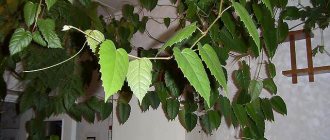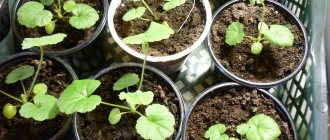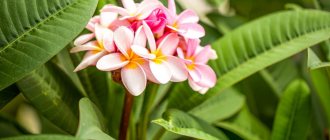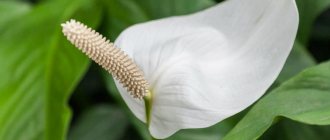The indoor crossander flower is still gaining popularity among amateur gardeners. Everyone likes its spectacular appearance, long and lush flowering, and longevity. But not everyone knows how to properly care for it. It would be a pity if an exotic bush, bought for a lot of money, quickly withers in your apartment, never delighting you with its magnificent inflorescences. To prevent this from happening, carefully read our article, in which we tried to describe in detail all the nuances of caring for Crossandra at home.
Brief description of cultivation
- Bloom . It begins in the spring and ends in the autumn.
- Illumination . The light needs to be bright, but diffused.
- Temperature regime . During the growing season, the temperature should be close to room temperature, and in the winter months - from 18 to 16 degrees.
- Watering . During the growing season, water abundantly immediately after the top layer of the substrate has dried. In the cold season, watering should be moderate or scanty.
- Air humidity . High. To do this, the air around the bush is regularly moistened with a fine spray, and it is recommended to pour expanded clay into the tray and pour in a little water.
- Fertilizer . They begin to feed the bush in the spring, and when it fades, stop applying fertilizers. To do this, use a mineral complex for flowering plants, which is added to the substrate once every 15–30 days.
- Rest period . From the time the bush fades until the onset of spring.
- Trimming . It is carried out at the end of flowering or at the very beginning of the growing season.
- Transplant . While the crossandra is young, it is replanted once a year, and when it grows up - once every 2 or 3 years.
- Reproduction . The most common method is cuttings, but the seed method is also popular.
- Diseases . Problems with the plant can begin due to poor care or unsuitable conditions. For example, mold may appear on the foliage.
- Pests . Spider mites.
Bloom
Crossandra blooms with spikelets of bright flowers. The most common color is orange.
Depending on the variety, they can be orange, yellow, pink, blue and green. With sufficient care, crossandra blooms from spring to autumn. Flowering is also possible in winter, but this greatly depletes the plant. Therefore, in winter the flower should be dormant.
It is recommended to remove bloomed buds in a timely manner. To do this, the flower stem above the top pair of leaves is cut. Thanks to this operation, new buds will appear on the bush.
Features of Crossandra
Crossandra is a subshrub that can reach 0.3–0.5 m in height. Its glossy bare opposite leaf blades have a pointed tip at the top and a dark green color; they can be wavy to varying degrees along the edge, and reach a length of 7 to 12 centimeters. During flowering, an axillary dense inflorescence in the shape of a tetrahedral spike is formed. The flowers reach about 2.5 cm in diameter and are salmon-colored. This plant is a very close relative of such crops as: pachystachys, aphelandra and ruellia.
#Houseplant Crossandra is a Ceylon beauty. Care, cuttings.
Without the slightest flaw
If we organized a beauty contest among trees, then the chestnut would, without a doubt, take one of the prizes. The refined and extraordinary beauty of the inflorescences, leaves and luxurious crown look harmonious with the formidable appearance of this titanium. This paradoxical combination can be characterized by the following series of magnificent features:
- inflorescences are presented in the form of pyramidal candles (each up to 15 cm in length);
- cream-colored flowers with pinkish spots and oblong tendrils in the center;
- the leaves are collected in luxurious fans (5-7 in one bunch), which are arranged spirally on the shoots;
- oblong leaves (10-20 cm) of dark green color have a jagged edge and are shaped like the tip of a medieval spear;
- the dense crown of an ovoid/round shape grows up to 20 meters in width;
- Brown fruits with a glossy coating are hidden by a prickly shell, which breaks into four parts when ripe or hit hard;
- The lower part of the trunk becomes bare over time, and the tree takes on a chic appearance.
These perennial plants love the sun so much that they grow up to 15-30 meters. Of course, such a result can only be expected after several decades. In this regard, many are interested in how long a chestnut tree grows. It is worth knowing that in 12 months the trunk of this giant increases by 30-50 cm. Therefore, by the fourth year of its existence, its height will be about 1 meter. At the same time, the tree will be able to meet the 10th spring of its “life” with charming blossoms and luxurious fruits.
Caring for crossandra at home
Lighting
Indoor crossandra needs a lot of bright diffused light. A window with a western or eastern orientation is best suited for it. You can also place the bush on a window facing the south side of the room, but in this case it will need to be protected from direct sunlight in the afternoon. Crossandra will not be able to grow normally on a northern windowsill. Due to poor lighting, it weakens greatly and refuses to bloom.
Temperature
During the growing season, the bush feels normal at air temperatures close to room temperature. Protect it from sudden changes in temperature, as this can lead to the loss of foliage. In winter, make sure that the room where the flower is located is not colder than 18 degrees.
Watering crossandra
During the growing season, the bush is watered regularly and abundantly. This is done immediately after the surface of the substrate has dried well to a not very great depth. In winter, water the flower less often and less abundantly, but at the same time make sure that the lump of earth in the pot never dries out.
Crossandra should be watered with soft water. Well-settled (at least 24 hours) or filtered tap water is suitable for this. Its temperature should be close to room temperature or slightly higher.
Air humidity
This flower reacts extremely negatively to low air humidity. In this regard, it needs regular and frequent moistening from a sprayer. The fact is that crossandra comes from the tropics. And there, after heavy rainfalls, the evaporation of moisture from the soil occurs very slowly, so the air humidity is almost always high.
Remember that it is not the bush itself that should be moistened with a fine spray, but the air around it. Make sure that there are no drops of water on the surface of the foliage or flowers. Do not water the plant too often, as this may cause rot.
Top dressing
Crossandra growing indoors needs regular feeding. If the bush experiences a lack of nutrients, it may lose its decorative properties. They feed it in the spring-summer period once every 2 weeks, for this they use complex mineral fertilizer. In winter, the soil mixture in the pot does not need to be fertilized at all. However, if desired, fertilizing can still be done once every 1–2 months. If the bush blooms in winter, then it is necessary to feed it. Do not forget that the nutrient mixture is added to the substrate only after preliminary watering.
Crossandra transplant
Such a “guest from the tropics”, growing indoors, needs systematic replanting. Moreover, while the bush is young, this procedure is carried out once a year. Adult, fully formed and well-developed bushes are replanted once every 2 or 3 years.
A suitable soil mixture should be fertile and loose. To prepare it with your own hands, it is enough to combine peat, humus, sand, leaf and turf soil, which are taken in equal proportions. At the bottom of the container, do not forget to make a good drainage layer, this will help avoid stagnation of moisture in the soil mixture.
Carefully transplant the bush from the old container to the new one, it is recommended to use the transshipment method. Fill all voids with fresh substrate. The transplanted flower is watered, and when the water is absorbed, more soil mixture is added to the pot if necessary. Make sure that there are no voids left near the roots.
ROOM FLOWERS | CROSSANDRA CARE AND TRANSPLANT
Trimming
Pruning is carried out shortly before the growing season begins or after the bush has finished flowering. To do this, all stems are shortened by 1/3. After the bush begins to actively grow, regularly pinch the tops of the shoots, in this case you will be able to form a thick and powerful bush. If you trim the crossandra in a timely manner, this will have a positive effect on its flowering, which will be lush, systematic and relatively long. But remember that from the fifth year of growth the bush begins to gradually bloom worse and worse.
Crossanra - plant transplantation
Indoor crossandra flower: Photo
There is a difference between transplanting a young plant and an adult one. Let's look at each type of transplant separately.
How to replant a young plant
Where to start immediately after purchasing a Crossandra? How to transplant it correctly?
If your plant is in bloom, then it should be replanted after about 7 days. Flowers in the store are treated with growth stimulants for a spectacular appearance. Perhaps the flower has been waiting for you for a long time, and it no longer has enough strength.
So, first you need to wait until the flower has completely faded, and only then start replanting.
First, water the soil thoroughly so that the earthen ball is completely moistened. After removing the flower from the pot, shake off the store-bought substrate, leaving only what is not shaken off from the roots. The pot should be more spacious compared to a store-bought one, and the bottom should have holes.
Drainage (expanded clay or small pebbles) should be placed at the bottom of the pot, followed by nutrient soil. Carefully, without damaging the roots, the bush is placed in a new pot with soil. Add nutrient soil, filling all the free spaces with it. Watering should be small, then add a little soil and water again. There will definitely be excess water in the pan.
The young crossandra is transplanted every spring for three years into a larger pot (by transfer). But don't overdo it! Increase the size of the pot by 2-3 centimeters in diameter, otherwise too much excess water will accumulate.
How to transplant an adult plant
An adult plant does not like big changes, so it is better not to replant the crossandra for no reason. There must be the following reasons for this action:
- excessive filling of the pot space with roots;
- rotting of the root system.
First you need to rid the root system of rotten and damaged roots, trim them, being careful not to capture healthy tissue. Next, you should treat the wounds with charcoal or activated carbon. After freeing the potting container from the soil, wash and disinfect it. Now this pot can be used. Be sure to place a drainage base at the bottom. Water with Fitosporin or another fungicide to prevent root rot.
As for the soil, a special soil for azaleas is suitable, which contains compost soil, leaf soil, peat, perlite (or coarse sand) in a ratio of 3:3:3:1. You can prepare the soil mixture yourself, as long as it is loose and nutritious. To be on the safe side, steaming the soil and drainage for disinfecting purposes will not hurt.
A potting container for crossandra can be either ceramic or plastic. It is more important that there are holes in the bottom to remove excess moisture. The size of the pot should be suitable for the root system of the crossandra, and be more than three centimeters in diameter.
A large pot will not work, as in this case the root system will unnecessarily grow to the detriment of the above-ground part of the plant. Accordingly, things may not come to flowering. In addition, if there is excess wet soil, rotting of the roots may develop.
Reproduction methods
Homemade crossandra can be propagated either by cuttings or seeds.
Growing from seeds
Since crossandra rarely produces fruits containing seeds, gardeners rarely propagate it generatively. As for specialized stores, crossandra seeds cannot always be found there either.
However, if you managed to find the seeds, then it will not be difficult to grow lush, beautiful bushes from them. To do this, take a low, small container and fill it with a mixture of sand and peat (1:1). Sow seeds into it at a shallow depth. The crops are covered with glass or film on top, after which they are moved to a warm (about 23 degrees) place, while one must not forget to systematically remove condensation from the shelter, as well as promptly moisten the substrate from a spray bottle.
The first seedlings should appear after a few weeks. As soon as this happens, remove the cover. And when the bushes have formed 2 pairs of true leaf blades, they need to be picked into individual small pots or cups. When the transplanted seedling takes root and begins to grow, it is regularly pinched to make the bush more lush.
Crossandra from seeds. [Hope and Peace]
Cuttings
This tropical plant can be easily and quickly propagated by cuttings. First you need to prepare cuttings; for this, the stems are cut into pieces about 10 centimeters long. Remove the two lower leaf plates from the segments, after which they are placed in a container with water for rooting. When the roots of the cuttings reach a length of 25 mm, they can be planted in a soil mixture consisting of peat and sand, which are taken in equal proportions. After the cuttings take root, they are provided with the same care as adult specimens.
Crossandra. Propagation by cuttings. Part 1.Crossandra.
Pests and diseases of crossandra
Crossandra diseases and their treatment
Since crossandra prefers high air humidity, leaf mold often develops on it. It can be recognized by gray fluffy spots on the leaf blades. As soon as you find them, immediately cut out the diseased parts of the foliage, including healthy tissue. After this, treatment is carried out with a solution of a fungicidal drug. In order for the flower to recover completely, do not forget to follow the watering rules, and also monitor the air humidity in the room.
Failure to follow the rules for caring for crossandra may result in the following problems:
- Withering and flying leaves . This can happen if the bush is watered too rarely or sparingly. This may also be due to a sudden change in room temperature.
- Insufficiently lush flowering . This may be due to the fact that the bush is already very old or has been pruned incorrectly. This also happens when the crossandra feels a lack of light.
Pests
If the air in the room is dry, then spider mites can settle on the plant. They are so small that they cannot be seen with the naked eye. This is precisely why they are dangerous, because mites can only be detected when there are a lot of them on the plant. In this case, you can see the thinnest cobweb on the bush.
If there are few pests, then you can try to get rid of them by washing the flower under a warm shower. If there are a lot of ticks, then they can only be destroyed with a special acaricidal agent. To do this, you need to purchase Aktaru, Fitoverm, Actellik or Akarin in a specialized store.
Crossandra care at home
Types and varieties of crossandra with photos and names
Crossandra infundibuliformis
Either orange or wavy - the height of such a subshrub can vary from 0.3 to 0.9 m. However, when grown indoors, the bush, as a rule, does not exceed 0.6 m. Its narrow leaf plates, pointed at the top, are long reach 12 centimeters and have a characteristic wavy edge. The five-petalled tubular flowers have large green bracts. They are orange-pink in color and have a yellow center. The flowers are part of a spike-shaped tetrahedral inflorescence, which is about 10 centimeters long.
The best varieties:
- Mona Wellhead . This variety is very popular in indoor cultivation. The height of the bush is about 0.45 m, and it is decorated with pink-salmon flowers.
- Tropic. The compact bush reaches 20 centimeters in diameter and 25 centimeters in height. This variety can be cultivated both at home and in the garden as an annual plant. This series includes several varieties that differ from each other in the color of the inflorescences:
- Tropic Splash - at the base the petals are painted in a dark yellow shade, while at the tops they are lighter;
- Tropic Flame - orange-salmon inflorescences.
- Orange marmalade . The height of the bush of this cultivar is approximately 0.6 m; it is decorated with flowers of a rich orange hue.
- Queen of the Nile . The inflorescences are painted in a rare terracotta shade.
- Crossandra Fortuna . The compact bush has a powerful root system, so it is more resistant to low air humidity and sudden temperature changes. The flowers are salmon-orange.
Crossandra pungens
This species is native to East Africa. The height of the bush is 0.4–0.6 m, its lanceolate leaf plates of variegated color have petioles. The surface of the foliage is decorated with silvery veins. The size of the foliage directly depends on where they are located: the upper plates are 60 mm long and 15 mm wide, and the lower ones are 120 mm long and 25 mm wide.
Red crossandra (Crossandra nilotica), or Nile crossandra
In nature, the bush can be found in Kenya and Mozambique. The height of this subshrub is about 0.6 m, its glossy, dense leaf plates of dark green color have an elliptical shape. The short apical inflorescences consist of tubular, five-lobed flowers of a salmon-pink or brick-red hue.
Stem crossandra (Crossandra subacaulis)
This plant is grown by gardeners quite rarely; most often it can be seen among collectors. The homeland of such a low-growing flower is the eastern part of Africa, namely Tanzania, Congo, Kenya and Uganda. The height of the bush is about 15 centimeters. Rich orange flowers are collected in inflorescences, the length of which does not exceed 10 centimeters.
Crossandra guineensis
This species can be seen just as rarely. The height of the bush is about 20 centimeters, its surface is covered with short pile. Short-petioled green leaf blades have pronounced veins on the underside. Light lilac or white flowers reach 20 mm in diameter, they are collected in narrow spikelets, the length of which is 5–15 centimeters.
Also in indoor culture, turquoise or blue crossandra is often found. However, this plant is part of another genus of the Acanthus family called Ecbolium.
Collection. Crossandra. From sowing to flowering.//Valentina Zemskova
What makes this rare flowerpot different?
This plant was brought from the tropics to our continent 200 years ago, but all this time crossandra was grown in greenhouses, so it did not gain mass popularity. But finally, breeders have developed varieties that can bloom beautifully on windowsills, and the “takeover” of the homes of our fellow citizens has begun!
“In the wild,” this meter-long bush blooms all year round in Madagascar and Sri Lanka, in the Asian and African tropics.
Our flowerpot does not have enough light, so its flowering time occurs only in the summer (if care is good, flowering begins in the spring and continues until autumn). The flowerpot can be made to bloom in winter, keeping it under a phytolamp all the time. However, it is more reasonable to give him a break.
This is what crossandra looks like:
- this is a bush that grows to a maximum of 70 cm;
- straight stems are covered with brown or green bark;
- the leaves are large (up to 8 cm), oval, with a sharp “nose”;
- the leaf surface is quite interesting - it is both pubescent and glossy;
- flowers are formed into a “cap” at the end of the shoots, its length reaches 15 cm;
- If the wilted inflorescences are not cut off, they will leave fruit behind.
It is curious that the bush deliberately loses ripe seeds. Falling into the soil of a crossandra pot or neighboring flowerpots, the seed pod explodes, releasing them to freedom.
Popular types and varieties of such plants
There are about 50 types of flowers, but these are in the wild. I will show you those that have been adapted for breeding at home.
- Fortune . The most popular flowerpot with slightly shiny leaves and lush orange inflorescences.
- Tropic yellow . A hybrid with light orange flowers (but not as lush as Fortuna). This flower takes root not only on the windowsill, but also in open ground.
- Funnel-shaped . Lush and long pleasing to the eye with salmon-colored inflorescences. It was this species that gave birth to most modern indoor varieties.
- Nile . A plant with pink or red flowers.
- Prickly . An interesting species with yellow flowers and decorative leaves (large, dark green, with striking white veins).
- Variegated . It has green leaves with thick white specks, so it is beautiful all year round. May bloom pink.
- Blue . Its flowers have a soft heavenly hue. Unfortunately, they are small, so this species is not very popular.
- Green Ice . The flowers in this flowerpot are white, slightly greenish. It can be grown on the same windowsill with other crossanders - you get a beautiful contrasting composition.
- Guinean . Blooms with purple flowers.











